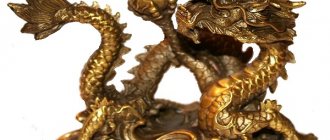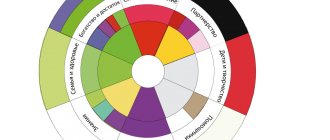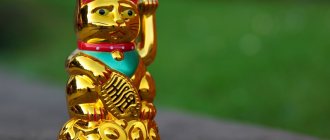| heron Greek . —Herodios lat . —Ardea A large, long-legged wading bird with a sharp and long beak. Has a symbolic meaning based on, g.o. on features of appearance and behavior. The solar bird, the personification of waters and dawn: standing in the water/on the shore, it is the first to meet and greet the morning star. Shares symbolism:
Unlike the latter, the long beak of a heron is considered not a phallic symbol, but a sign of curiosity (cf.: “poking your nose everywhere”) and interest. Basic values:
|
Content
- 1 Basic values:
- 2 Egypt
- 3 Antiquity
- 4 Northern tradition
- 5 Southeast Asia
- 6 China
- 7 Buddhism
- 8 Taoism
- 9 Christianity
- 10 Fortune telling
- 11 Heraldry
- 12 Emblems
- 13 Art
- 14 Ad vocem
- 15 Literature
- 16 Notes and comments
See also:
Birds Solar bird Poseidon Frigga Benu Stork Crane
Purpose of the figurine
Each talisman in Feng Shui has its own meaning and has its own unique abilities. Depending on their location, amulets and talismans can influence the energy background of your home or office to varying degrees.
The talisman is intended for cleansing and protection from negative energy, personifies longevity and health, in particular, to protect the entire family, home, hearth, family traditions and customs, and attracts happiness to the house.
In general, the image of a stork symbolizes renewal (the arrival of spring), changes in life, and promotes favorable changes in life.
Very rarely, the image of a stork or heron is equated with the image of a crane.
The main purpose of the heron talisman according to Feng Shui is to cleanse its owners from negativity and filth. Also, the calling of a heron in your home is to protect your entire family from the effects of various evil spirits.
That is why the heron according to Feng Shui is used mainly to store the hearth, protect the home, your family traditions and customs. The Heron is a personal protector for what is important and sacred in your family.
Antiquity
The legendary enemy of the eagle and the lark, but the friend of the crow.
Sacred bird of Poseidon.
Mediterranean sailors considered the heron to be the bird of Aphrodite and the patroness of sailors.
Her appearance was perceived as a favorable sign (augurium). The white heron promised special luck.
“A heron appeared, flying from the right side, and although it was not possible to see it properly, since it was night, the cry of the heron delighted Odysseus.” Homer "Iliad"
By the way the heron hides, the weather, mainly rains and storms, was predicted with great accuracy.
Like the bittern, a symbol of constant idleness and laziness: in Ancient Greece it was believed that these birds, hiding in the reed thickets all day, were turned into slaves of herons.
When Aeneas destroyed the capital of the Rutulians - the city of Ardeen, birds were found among the ashes, which in Latin were called: “Ardeae”, that is, “a genus of herons” (“Metamorphoses” by Ovid).
According to Pliny the Elder, when mating, herons experience the same sensations as when laying eggs, and among other things, they could shed tears from sadness and sadness.
In Aesop's fable, she must risk her head to pull a bone out of a wolf's mouth.
Location of the figurine
Stork (heron) is a sunny bird. This should be taken into account when choosing the location of the figurine. The best way to activate it is to place the figurine on the sunny side
In addition, the crane is an aquatic bird. That is why proximity to water (you can place the figurine next to an aquarium, fountain, vase with water) also activates the effect of the talisman on the environment.
And if you place the figurine in a nest (even if it is symbolic), then the figurine will be firmly “connected” with the owner’s apartment and will double its properties.
If you place a pine tree or its image next to the heron figurine, the power of the talisman, which is responsible for health and longevity, will be most activated.
The stork is often the talisman of the sector of Love, Family and Children. Depending on what kind of influence the owner of the figurine wants to achieve, the position of the figurine should be determined:
- in the Love sector the figurine is placed if they want to have offspring and strengthen love bonds,
- in the Family sector - if they want to strengthen relationships in the family, between generations and want to raise and educate children who will honor the older generation,
- in the Children sector, the figurine is placed in the desire to have offspring. The figurine of a stork (heron) with Lao Tzu holding a peach will have an even greater impact.
Source: www.ekstrasensy.su
Christianity
One of the birds that knows “their specific times”[1].
The early Christian Physiologist points out that the heron is the most unpretentious of all birds: “its bed and its table are in the same place” and does not “fly here and there.” Therefore, it serves as a symbol of a Christian who should not visit many places of heretics, but must protect himself from the “brew of heretical and erroneous teachings.”
According to the medieval Bestiary, the heron has an aversion to rain and flies high above the clouds, foreshadowing a thunderstorm. Sometimes found as an allegory of believers rising above the storms of life like a heron overcoming rain clouds.
Symbol:
- Christ on the Mount of Olives - due to the legendary ability to shed tears;
- Christ “slaying” Satan - as a destroyer of snakes
- repentance - by the ashen color of the plumage of a gray heron.
How to activate the heron talisman in feng shui
Heron mascot
The heron is considered a sun bird. To activate the heron talisman, you should place its figurine on the sunny side of your house. Thus, by absorbing the energy of the sun, the heron works better and brings more benefits.
If you have a decorative fountain or aquarium in your home, place it next to the heron as well. Proximity to water has a creative effect on activating the talisman into action.
If you place the heron talisman over the symbolic nest, then the heron will acquire very close contact with your home and will be able to show maximum care to you and your children.
A heron, as a mascot in your home, can do a lot for you. In a variety of world cultures and traditions, this noble bird is considered a symbol of freedom, wind, sun and sky, abundance, protection and inspiration. The heron mascot is ready to do a lot for its admirers.
Emblematics
“This bird is a symbol of the souls of the chosen ones, who, out of fear of the storms of this world, direct all their aspirations beyond the boundaries of mortal existence to the heights of their heavenly homeland. Some of the herons are white, others are ash-gray; white is the color of innocence, ash-gray is the color of repentance...” Unterkircher “The heron, when it senses impending bad weather, Prudently rises above the storm clouds. So the pious heart, when trouble is about to strike, tends to seek refuge only in God’s Kindness.” Hochberg. 1675
A heron carrying a flower in its beak.
- You know them all.
A symbol of the instincts and knowledge that herons are endowed with.
EMSI 51-15 Heron flying above the clouds.
- I am above all hurricanes and storms.
A symbol of aspiration to heaven. “He whose goal is above the clouds becomes inaccessible to hurricanes and storms - unrest and anxiety.” EMSI 23-9
Material of figurines
The material for making the figurine should be natural material, because... It is precisely such materials that are a source of positive energy:
- wood - wooden figurines should be placed in the Family zone,
- metal is responsible for the Travel and Childhood zones,
- stone – travelers are recommended to place products made from this material in the Knowledge zone.
In addition, figures can be made from:
- ceramics - is a symbol of the Earth and strengthens the atmosphere in the house,
- porcelain - is a symbol of the Earth and strengthens the atmosphere in the house,
- crystal - passes negative energy through itself, transforming it into positive.
Types of herons and their characteristics
There are many species of herons in the world (about 60).
- Gray Heron. One of the largest representatives of the heron family, its height can reach a meter, and its average weight is about two kilograms. Most often the bird is found in Eurasia, Africa and Indonesia. The plumage is gray with black stripes, and there is a black crest on the head. The beak is yellow.
- Great White Heron. It is distinguished by its snow-white plumage and large size - the weight of an adult male is about 1 kg and the height is 1 m. It is found in warm latitudes - in Europe, New Zealand, Asia, Africa, Australia, South America. The heron is listed in the Red Book of Russia.
Photo of great egret - Little white heron. The second name is chepura-need. This is a small bird that is common in the Eastern Hemisphere. In Russia, it can be found in the European part of the country near large rivers. The plumage color is white, average weight is no more than 600 grams.
- Big blue. This is a close relative of the gray heron, but it lives in India, Central and South America, and is found on the Galapagos Islands. She was also seen on Ratmanov Island in Russia, but she ended up there, most likely, by mistake. The bird is large, its weight can reach 2.5 kilograms, and its height is 1.4 meters. The feathers are gray and there are brown and black stripes on the neck.
- Shoebill heron. It is also called the royal heron. Belongs to the shoebill family. Lives in East Africa. The peculiarity of the bird is that its eyes are located in the front, and not on the sides, like other birds. The shoebill is also easily recognized by its large beak, which closely resembles a shoe made of wood.
The beak of the shoebill heron resembles a large wooden shoe - Great heron or little bittern. This is the smallest representative of herons, whose height barely reaches 36 centimeters. The bird weighs about 150 grams. It lives in Africa, Russia and other European countries, India, Australia. The little heron is the only species of heron in which the male and female are different in color. The former have black plumage, and the latter have brown plumage.
- Heron heron. The second name is night heron. A small bird found on all continents except Australia and Antarctica. It is predominantly nocturnal and sits motionless on branches during the day.
- Giant or Goliath heron. Distributed mainly in Africa, in areas located south of the Sahara. Occasionally it can be found in Asia. Prefers to lead a sedentary lifestyle. Weighs up to 7 kilograms, height can reach one and a half meters. For such large dimensions, the bird is called a giant.
Goliath Heron - a large and beautiful bird - Medium white. A small bird with white plumage. Found mainly in Africa, South Asia and Australia. It was spotted in Russia in the Far East.
- White-necked. The second name is Pacific heron. Most representatives of the species live in Australia, but these herons are also found on the island of Tasmania, New Zealand and New Guinea. It is a large bird with black or gray feathers on its body. The neck and head are white.
- Black-necked. Lives in South Africa and Madagascar. Externally, it is very similar to the gray heron, only with a darker color. Short in stature, about 70–80 centimeters.
- South American. Most individuals live throughout South America. Some specimens may fly to the Falkland Islands and Trinidad and Tobago. A large bird weighing up to 2.5 kilograms and more than a meter tall. The plumage is gray, the legs are pink. The head and neck are white, with a black crest.
- Madagascar. This is a rare bird found exclusively in Madagascar. It is listed in the IUCN (International Union for Conservation of Nature) Red List as an endangered species. The heron is small in size, up to about 90 centimeters. Feather color is gray.
A rare species of heron - Madagascar - Redhead. It is found mainly in reeds. Found in European countries, southern Asia and Africa. The color is dim, for easy camouflage. The plumage is red and gray. Very long fingers with sharp claws.
- White-winged. A small bird living in South and East Asia. Individual representatives can be found in Mediterranean countries and in the Primorsky Territory. The bird is very beautiful, especially during the mating season - the head and neck are reddish, the back is gray, and the sides and lower part are white. The height of a heron is no more than half a meter.
- White-bellied. The rarest heron, which is found only in the foothills of the Himalayas in Bhutan, India and Myanmar. Previously nested in Bangladesh and Nepal, but no longer occurs there. Several hundred individuals remain. A large bird, second in size only to gigantic herons. The plumage is mostly gray. Many efforts are being made to protect it; it lives in national parks and reserves. In 2011, the white-bellied heron appeared in captivity for the first time. She was released into the wild after being equipped with a sensor to track her movements.
- Egyptian. One of the most numerous representatives of the heron family, inhabiting almost the entire planet, except for cold areas covered with ice. The bird has a dense, massive body, a relatively short neck and beak. The color of the feathers is white; during the mating season they turn bright colors - orange, yellow, golden.
Singing herons
They voice most often during flights, making sharp sounds that are more like a grinding or hoarse croak. On land they are rather silent birds. They prefer to “talk” only with their fellow tribesmen and do not communicate with other birds. When greeting, herons quickly click their beaks. When they are threatened with danger, and they want to warn their fellow tribesmen about it, they bend their necks and emit a guttural cackle. And if the heron, on the contrary, poses a threat itself, it begins to scream, and vibrating notes can be heard in the scream.
We invite you to watch a short video that demonstrates the singing of herons.
Heron populations
Today, only two species of the heron family are in danger - the Madagascar (about 1,000 individuals left) and the white-bellied (there are even fewer, no more than 300). These herons are listed in the Red Book as an endangered species and a species on the verge of extinction, respectively.
But back in the century before last, the heron was almost destroyed for the sake of beauty - long feathers looked great on the hats of fashionistas of that time. Because of this, up to 2 million individuals per year were destroyed in North America and Europe alone. Because of this, more than 50 species of herons were completely exterminated.
And 50 years ago the world could have lost the gray heron. It was actively exterminated in Russia and China due to the fact that people thought that the bird was eating too much valuable commercial fish. Fortunately, the mistake was quickly cleared up and the gray heron population was not too affected. As it turned out, birds destroy only weak and sick fish, thereby clearing water bodies of them.
Photo of a heron standing on one leg
Currently, herons are mainly threatened by poachers, forest fires and anthropogenic activities, such as active road construction and drainage of swamps.
Heron lifestyle
Most often, herons live in entire flocks, which can include up to 1000 individuals. But such large colonies are found on the shores of those reservoirs where fish and other aquatic life are found in great abundance (most often in European countries). Basically, herons create colonies of 15–100 birds, and some species, for example, the Goliath heron, even prefer to live separately from everyone else, avoiding any proximity with relatives. Heron nests are located at a considerable distance from each other, maintaining distance. They do not form dense flocks.
During the day and at dusk, herons hunt, and at night they prefer to sleep closer to each other so that, if necessary, they can jointly defend themselves from enemies.
THIS IS INTERESTING. Colonies are often inhabited by herons of various species and even representatives of other families of birds - golden eagles, rooks, cormorants.
How does a heron fly
A heron in flight is a beautiful and unusual sight. It flies rather slowly and ponderously, which distinguishes it from storks or cranes, which are famous for their grace. If you look at a photo of a heron in flight, you will notice that the bird looks a little humpbacked.
In order to take off, it makes short and sharp wing beats, which become smoother after gaining the required height.
Photo of a heron in flight
The heron is capable of picking up speed up to 50 km/h in case of danger. Then its measured wing flapping changes to rapid and chaotic ones.










